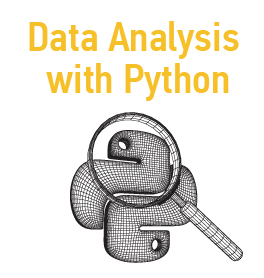Course Overview: Data Analysis using Python
Python has rapidly become one of the most sought-after languages for data analysis. From data cleansing to advanced predictive modeling, Python offers a vast range of libraries and tools for all your data science needs. This course introduces participants to the process of analyzing data using Python, equipping them with practical skills to extract insights from real-world data sets.
Learning Objectives:
By the end of the course, participants will be able to:
- Understand the Python programming environment and its advantages in data analysis.
- Cleanse, transform, and prepare raw data for analysis using Pandas.
- Create a variety of visualizations to explore and present data using Matplotlib and Seaborn.
- Implement statistical methods to analyze trends, patterns, and relationships in data.
- Use Python-based tools for web scraping and data extraction.
- Carry out predictive analytics using Python libraries such as scikit-learn.
- Efficiently handle large data sets using Python’s in-memory processing capabilities.
- Develop a data-driven decision-making mindset.
Target Audience:
- Beginners interested in data analysis and data science but have limited or no experience in Python.
- Professionals in fields like finance, marketing, and operations looking to add data analysis skills to their repertoire.
- Researchers aiming to leverage Python for data analysis in their projects.
- Current programmers and developers wishing to transition into the data science realm.
- Anyone looking to make sense of data and draw actionable insights.
Prerequisites:
Prior knowledge of Python
Course Curriculum: Data Analysis using Python
Module 1: Introduction to Data Analysis and Python
- What is Data Analysis?
- Introduction to Python and its Popularity in Data Analysis
- Setting Up the Python Environment
- Overview of Python Libraries: Pandas, Numpy, Matplotlib, and Seaborn
Module 2: Basics of Python for Data Analysis
- Python Data Types and Variables
- Control Structures: Loops and Conditional Statements
- Functions and Modules in Python
- Python’s Data Structures: Lists, Tuples, Dictionaries, and Sets
Module 3: Data Manipulation with Pandas
- Introduction to Pandas DataFrames and Series
- Importing and Exporting Data
- Data Cleaning: Handling Missing Values, Outliers, and Duplicates
- Data Transformation: Aggregating, Merging, and Reshaping Data
Module 4: Data Visualization using Matplotlib and Seaborn
- Basics of Matplotlib: Plotting, Labelling, and Styling
- Introduction to Seaborn: Advanced Visualization Techniques
- Creating Plots: Bar, Line, Scatter, and Histograms
- Customizing and Saving Visualizations
Module 5: Advanced Data Analysis Techniques
- Introduction to Statistical Analysis in Python
- Correlation and Regression Analysis
- Time Series Analysis
- Clustering and Classification using scikit-learn
Module 6: Web Scraping and Data Extraction with Python
- Introduction to Web Scraping
- Using Beautiful Soup and Requests for Data Extraction
- Handling Dynamic Web Pages with Selenium
- Storing Extracted Data in Pandas DataFrames
Module 7: Capstone Project and Course Wrap-up
- Choosing a Real-world Data Analysis Problem
- Applying Learned Techniques for Data Analysis and Visualization
- Presenting Insights and Findings
- Feedback Session and Course Closing Remarks
Feedback

Course Features
- Lectures 0
- Quizzes 0
- Duration 60 hours
- Skill level All levels
- Language English
- Students 10
- Certificate No
- Assessments Yes













